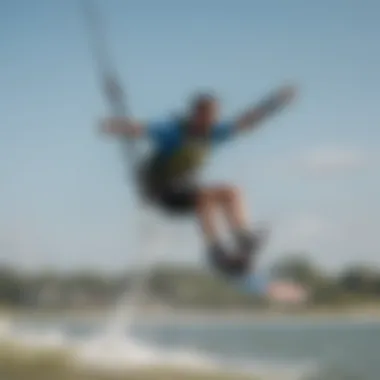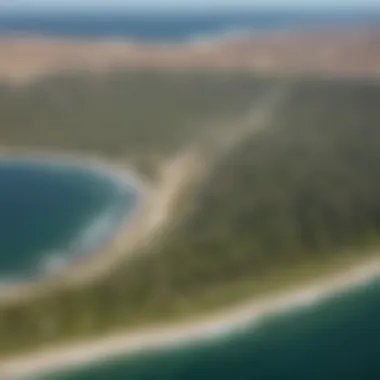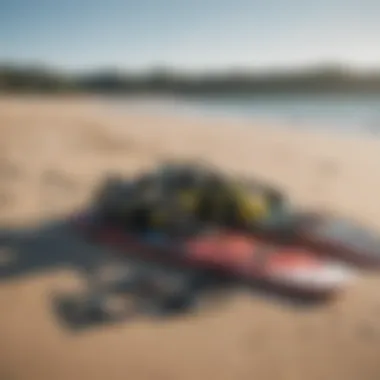Harnessing NJ Wind Speed Maps for Kiteboarding Success


Intro
Kiteboarding is a thrilling sport that dances at the intersection of skill, timing, and nature. In the vibrant state of New Jersey, the winds offer a unique playground for enthusiasts looking to harness the gusts and glide over water. However, before you launch your kite into the sky, understanding how to read and interpret wind speed maps becomes crucial. These maps are not just whimsical lines and colors on a screen; they represent the lifeblood of kiteboarding, guiding enthusiasts from novice to expert.
Wind speed maps in NJ are like a weather oracle—giving hints about the winds that can either elevate your kiteboarding experience or turn it into a struggle. To truly enjoy this sport, it’s important to grasp the implications of these maps, along with their nuances and fluctuations. This article will explore the essential role these maps play, focusing on key elements like gear selection, skill development, and local weather dynamics—ultimately helping you to make wise decisions and safe choices while kiteboarding.
Stay tuned, as we dive into the essential aspects of gear selection, what to keep in mind when reading the maps, and tips for developing your skills on the water. It’s not just about flying a kite; it’s about soaring with the winds.
Foreword to Wind Speed Maps
Wind speed maps are crucial tools that kiteboarders in New Jersey should not overlook. They serve a purpose far beyond merely tracking gusts and breezes. When it comes to kiteboarding, having access to accurate wind speed data can significantly enhance one’s playing field, offering insights into the ideal conditions needed for safe and fun riding. Whether you're a seasoned pro or just dipping your toes in the waters, understanding these maps can mean the difference between a fantastic day out on the waves or an experience marred by unsuitable weather.
Understanding Wind Speed in Kiteboarding
In the world of kiteboarding, wind is not just a factor; it’s the driving force. A keen understanding of wind speed helps riders choose when to hit the water, what gear to use, and how to navigate different conditions. For instance, light wind days might be ideal for beginners who are just getting the hang of controlling the kite, while experienced riders often prefer stronger winds for more dynamic and exhilarating rides.
Wind speed maps illustrate wind conditions in various regions, making it easier for enthusiasts to analyze when and where to kiteboard. By understanding the nuances of these maps, riders can interpret values, recognize prevailing winds, and adjust their plans accordingly.
Importance of Accurate Wind Data
Accurate wind data is not merely a nice addition; it’s vital for the safety and enjoyment of kiteboarding. Let’s face it, trusting your day to inaccurate data could lead to risky scenarios. A kiteboarder caught in unexpectedly strong winds without proper preparation is not only risking their gear but also their personal safety. Misreading wind conditions can also ruin an otherwise perfect outing.
Key points regarding the need for precise wind data include:
- Safety Assurance: Understanding actual wind speeds helps assess the risks of both conditions and locations.
- Gear Selection: Knowing the wind speed helps in choosing the correct kite size. A lighter, smaller kite works best in gentle winds, whereas stronger winds call for a larger kite, effectively preventing gear misuse.
- Session Planning: When you have robust data, planning becomes significantly easy. You can determine the best times to kiteboard, avoiding weather surprises.
"Being equipped with the right information is half the battle in kiteboarding; the other half is knowing how to utilize that info!"
Overall, wind speed maps are not simple visuals; they are comprehensive guides that can elevate an individual's kiteboarding experience when understood correctly.
New Jersey's Unique Wind Patterns
Understanding the unique wind patterns of New Jersey is paramount for kiteboarding enthusiasts looking to make the most of their time on the water. The state, bordered by the Atlantic and influenced by various geographical features, presents a complex blend of wind behaviors that can greatly affect kiteboarding experiences. Getting acquainted with these wind nuances means knowing when it’s best to grab the gear and hit the waves, while also recognizing the challenges that varying wind conditions can present.
Geographic Influences on Wind
New Jersey's geographical layout plays a crucial role in its wind patterns. The state's mix of coastal, inland, and elevated areas results in diverse airflow characteristics.
- Coastline Proximity: Being near the Atlantic Ocean significantly impacts wind speed and direction. Coastal breezes typically provide steadier winds during warm months. On hot days, the land heats up faster than the ocean, pulling in cool, moist air from the sea. Kiteboarders often benefit from these sea breezes, which can be consistent and reliable, making for ideal conditions.
- Terrain Variation: Inland areas, especially those with hills or valleys, can produce turbulent wind patterns. The unevenness of terrain can disrupt smooth airflow, introducing gusts and lulls that may catch even seasoned kiteboarders off-guard. It's vital to be aware of local geography as it can lead to unpredictable changes, requiring adjustments in technique and planning.
- Obstructions: Tall buildings, trees, or other structures can create wind shadows, where wind speed is less. For kiteboarders, launching from spots with fewer obstructions can make a world of difference, ensuring that they harness the full power of the wind.
A kiteboarder's location significantly impacts their experience, thus being mindful of the surrounding environment can enhance skill and safety on the water.


Seasonal Variations in Wind Speed
The seasons bring about notable shifts in wind conditions, directly influencing kiteboarding activities. Understanding these variations can dramatically improve planning and performance.
- Spring and Summer: As temperatures rise, the state often experiences more stable wind conditions. The transitions from cold fronts to warm fronts can generate excellent wind, particularly in late spring to mid-summer when thermal winds are common. This period often delivers optimal kiteboarding conditions, with consistent and moderate winds that cater well to both beginners and seasoned riders.
- Fall and Winter: Cooler months bring challenges and opportunities. While the overall wind speed tends to ramp up, the inconsistency also increases. Frontal systems and winter storms can lead to stronger gusts, but also periods of calm. Kiteboarders need to be cautious. Safety protocols become essential as strong winds can quickly escalate the difficulty of riding. Knowing how to read the weather and wind trends becomes a vital skill during these seasons.
- Weather Events: New Jersey's location makes it prone to weather patterns that can dramatically affect wind. Events like hurricanes or nor’easters can produce high winds, though they come with significant hazards. Kiteboarders should always stay informed and respect safety guidelines during these turbulent times.
Overall, adapting to these seasonal wind changes allows kiteboarders to plan effectively, ensuring they hit the water at the right time.
"Knowledge of wind patterns and seasonal variations can elevate a kiteboarder's performance and enjoyment on the water."
Considering both geographic influences and seasonal variations equips kiteboarding enthusiasts with the understanding needed to succeed in varying conditions, ultimately enhancing their kiteboarding adventures.
Interpreting NJ Wind Speed Maps
Understanding how to interpret New Jersey's wind speed maps is crucial for kiteboarding enthusiasts who wish to maximize their time on the water. These maps serve as a roadmap, guiding kiteboarders through the often unpredictable winds of the New Jersey coastline. When you grasp the nuances of these maps, you can make informed decisions that significantly impact your kiteboarding experience.
Key Elements of a Wind Speed Map
A wind speed map is not just a colorful collection of lines and shades; it contains essential data for any kiteboarder looking to harness the winds efficiently. Here are some key elements you need to pay attention to:
- Wind Speed Indicators: Usually displayed in knots, these indicators let you know how strong the wind is expected to be. A good rule of thumb is that somewhere between ten and twenty knots often provides ideal conditions for most kiteboarders.
- Wind Gradient: This shows how wind speed can change over short distances. A map illustrating a steep gradient indicates rapidly changing winds, which may not be suitable for beginner kiteboarders.
- Weather Icons: These can signal various conditions like rain, clouds, or clear skies, which are invaluable since weather impacts wind behavior.
By familiarizing yourself with these elements, you can quickly assess whether conditions will be optimal for a day of kiteboarding.
Color Coding and Its Significance
The color coding on wind speed maps is a vital feature that allows for instant visual assessment of the wind speeds across different areas. Each color typically corresponds to a specific wind speed range. For example, light blue may represent gentle breezes under ten knots while dark red could indicate strong winds exceeding thirty knots.
- Green Zones: Generally indicate favorable wind speeds, typically around ten to fifteen knots, perfect for enthusiasts at various skill levels.
- Yellow Zones: Caution is advised here; winds may be approaching the upper limits of comfort, particularly for less experienced riders.
- Red Zones: Strong winds can be hazardous and may lead to challenging conditions. It's best to avoid these areas unless you're certain of your skills.
Understanding these color codes can provide immediate insight into where to consider heading for a successful day on the water.
Reading Wind Direction
Another critical aspect of wind speed maps is understanding the wind direction and how it affects kiteboarding. Wind direction is often depicted with arrows or lines on the map. Here’s how to decipher them:
- Arrow Orientation: The direction in which the arrows point indicates where the wind is coming from. For kiteboarding, onshore winds are typically ideal, while offshore winds can present safety issues.
- Degrees: Some maps may also provide wind direction in degrees, which can be handy for those who are more technically inclined. For example, a north wind would be at 0 or 360 degrees, whereas a south wind would be at 180 degrees.
Knowing how to read wind direction helps kiteboarders select launch sites and plan their activities.
"By mastering wind maps, you don’t just make predictions; you gain a significant advantage on the water."
In summary, interpreting New Jersey's wind speed maps is an essential skill for kiteboarders of all levels. By focusing on the key elements, benefits of color coding, and the nuances of wind direction, you can enhance your kiteboarding journey, making each outing more enjoyable and safe.


Practical Applications for Kiteboarders
Understanding wind speed maps is essential for kiteboarding enthusiasts who want to make the most of their sessions. They allow kiteboarders to anticipate wind conditions before heading out, ensuring that every outing can be both thrilling and safe. By analyzing these maps, riders can plan their sessions more effectively, select appropriate gear, and adhere to safety measures based on live wind data.
Planning Your Kiteboarding Sessions
When planning a kiteboarding session, wind conditions are often the most crucial factor to consider. A wind speed map provides insight into the expected wind speeds at various times of the day. This information can help kiteboarders determine the best times to hit the water.
- Timing: For instance, morning winds might be calm, but as the day progresses, they could pick up significantly. Riders can use this knowledge to plan their sessions for when winds are at their peak.
- Location Choice: Different spots may experience varying wind speeds due to geographical features. A kiteboarder could look at the map and choose a coastal section known for stronger winds at their desired time.
Choosing Appropriate Gear Based on Wind Speed
Selecting the right gear is integral to having a successful kiteboarding experience. The choice of kite size, board, and harness can significantly affect performance. Wind speed maps guide kiteboarders in choosing their equipment, ensuring they are adequately prepared for the day.
- Kite Size: Light winds might call for larger kites to generate sufficient lift while stronger winds may necessitate smaller kites to maintain control.
- Board Type: Some boards perform better in certain conditions. For example, a twin-tip board may be ideal for choppy waters, while directional boards may excel in more stable, higher winds.
Being adaptable can make the difference between a memorable session and a frustrating one.
Considering Safety Protocols with Wind Data
Safety should always be at the forefront of kiteboarding. Wind speed maps can play a pivotal role here. Understanding how wind impacts conditions can help kiteboarders take necessary precautions.
"Knowing the wind is like knowing the ocean; it’s about respecting its power and planning accordingly."
- Monitor Changes: Wind speeds can shift unexpectedly, leading to dangerous conditions. Regular checks help kiteboarders stay aware of changing weather patterns.
- Emergency Plans: Good preparation involves having a safety plan. If wind speeds increase and conditions become perilous, knowing how to react swiftly is key.
Technological Advances in Wind Mapping
The world of kiteboarding is not merely about having fun on the water; the success of every session relies heavily on knowing when and where to catch the wind just right. Recent technological advancements have transformed how kiteboarders approach wind mapping, allowing for more precise and reliable data than ever before. With these innovations at your fingertips, understanding wind behavior becomes simpler and more intuitive, thus empowering enthusiasts to optimize their time on the water.
How Technology Improves Accuracy
One major leap in accuracy comes from the use of sophisticated meteorological instruments and advanced algorithms that synthesize weather data from multiple sources. These tools, including Doppler radar and anemometers, provide real-time readings of wind speeds and directions. This data is not only more precise but also instantly accessible.
- Enhanced Data Collection: Automated stations scattered across various locations gather wind data continuously, removing much of the guesswork involved in traditional methods. By comparing historical data to real-time statistics, kiteboarders can predict changes with much greater accuracy.
- Predictive Modeling: Algorithms analyze patterns from past and present data, which aids in forecasting future conditions. Rather than depending exclusively on outdated models, kiteboarders can use these enhanced predictions to decide their outings with confidence.
In practical terms, this means a kiteboarder can trust that what they see on their wind speed map reflects reality. A day that seems perfect for session can easily turn sour due to sudden wind shifts; yet technology offers the tools to foresee these developments ahead of time.
Mobile Apps and Wind Speed Tracking
In recent years, mobile applications have taken center stage in the realm of wind tracking. Kiteboarders can now carry the power of high-tech wind monitoring right in their pockets.


- Real-Time Updates: Apps like Windy or Kitesurfing Weather alert users with live updates on wind speeds, temperatures, and even wave heights. This info is crucial for planning last-minute trips or adjusting your gear on the fly.
- User-Friendly Interfaces: These applications often feature intuitive layouts, employing color-coded indicators to communicate wind strength quickly. This means a kiteboarder can glance at their phone and make an informed decision without sifting through piles of data.
- Community Feedback: Many of these platforms incorporate user-generated reports, offering a grassroots view of current conditions based on honest experiences. If a local spot is experiencing unexpected gusts, a real-time report from fellow kiteboarders can shift the course of the day.
Mobile apps are enabling kiteboarders to stay ahead of the wind, ensuring that whether you're a newbie or an expert, you can harness every breeze to its fullest potential.
"With the right tech, we're no longer just at the mercy of nature; we can actively engage with it."
In summary, advancements in wind mapping technology and mobile application integration have unlocked a wealth of data for kiteboarding enthusiasts. By leveraging these tools, kiteboarders can gain better insights, make informed decisions, and enhance their overall experiences on the water.
Historical Wind Data Analysis
Analyzing historical wind data is not just a casual pursuit for kiteboarding enthusiasts; it serves as a vital compass guiding their adventures on the water. When seasoned kiteboarders reflect on their past experiences, they often rely on wind patterns that have shaped their outings. Accurately understanding historical data allows kiteboarders to recognize consistent trends, forecast future wind conditions, and improve their overall performance, making every outing feel like second nature.
Trends Over Time
When one dives into historical wind data for New Jersey, a few significant trends stand out. Over the years, records show fluctuations in wind speed and direction that have profound implications for kiteboarding.
- Increased Wind Speeds: Data reveals that average wind speeds have ticked up slightly in recent years, providing kiteboarders with more opportunities to catch the wind's favor.
- Shift in Seasonal Winds: Certain seasons have started to exhibit unique wind behavior. For example, winter months now occasionally bring tropical storm remnants, which create gusty conditions not typically seen. This shift can offer thrilling challenges for those willing to brave chillier waters.
- Concentration of Wind Events: Kiteboarders increasingly notice that particular weekends or holidays experience stronger winds than usual, coinciding with major weather patterns. Understanding this trend allows kiteboarders to plan better, strategically selecting their sessions when conditions are ripe for exhilaration.
"Wind patterns are not just random; they paint a picture of what our kiteboarding future could look like. Knowing them is like having an edge every time you set foot on the water."
Impact of Climate Change on Wind Patterns
In recent discussions about the environment, the spotlight often shines on how climate change influences daily life, which includes wind conditions critical to kiteboarders.
- Variability in Wind Patterns: Historical data highlights that climate change can lead to more erratic wind patterns. This unpredictability means that kiteboarders must adapt their strategies to grasp when the winds will truly favor their hobbies.
- Increased Storm Frequency: Data shows an uptick in storm frequency, which can drastically change wind behavior. For example, the late summer months used to be viewed as relatively calm. Now, sudden squalls have become not just a possibility but a routine surprise for those who dare to ride.
- Temperature Influence: The changing climate affects thermal winds, which are especially relevant in coastal areas. As land and water temperatures shift, so too does the wind. Kiteboarders need to stay informed about how temperature trends can lead to stronger or weaker winds in their locales.
Our understanding of historical wind data is a crucial tool for kiteboarders. It guides choices, helps predict outcomes, and ultimately enriches the joy of the sport. By marrying these insights with current wind speed maps and forecasts, kiteboarders can truly embrace each moment spent riding the waves.
Closure and Recommendations
Understanding wind speed maps is not just a matter of technical curiosity for kiteboarding enthusiasts; it’s the cornerstone of successful and safe kiteboarding experiences in New Jersey. This section will delve into practical ways to weave the insights gained from this article into your regular kiteboarding practices. Additionally, maintaining a commitment to learning about wind conditions can significantly enhance your performance and safety while navigating the waterways.
Integrating Wind Speed Data into Your Kiteboarding Routine
Integrating wind speed data into your routine requires both awareness and action. Kiteboarders should first familiarize themselves with the specific maps and resources available for New Jersey wind forecasts. For instance, utilizing platforms like NOAA or regional wind maps can provide a solid baseline for understanding anticipated conditions. Here are a few steps to help you out:
- Daily Checks: Make it a habit to check wind speed and direction daily before heading out. These data points can vary significantly even over short distances.
- Location-Specific Insights: Different beaches in New Jersey can exhibit distinct wind behaviors. Get to know these quirks, whether it’s the coastal winds at Cape May or the breezy conditions at Long Beach Island.
- Adjust Your Gear Accordingly: Having the right kite size for prevailing conditions is crucial. Lighter winds may call for larger kites, while stronger gusts require smaller ones to maintain control.
Above all, creating a checklist of essential wind data before planning a session ensures you never hit the water underprepared.
Continuing Education on Wind Conditions
The dynamic and somewhat unpredictable nature of wind conditions means there’s always more to learn. Kiteboarding isn’t a static sport; conditions are in a state of flux constantly. Here’s how you can keep your knowledge fresh:
- Attend Workshops and Clinics: Many kiteboarding schools offer specialized courses that not only cover skills but also delve into wind theory. Engaging with experts can shed light on navigating various wind situations.
- Follow Local Weather Services: Keep an eye on local meteorological updates and their forecast adjustments. Platforms such as Reddit and Facebook can be invaluable for real-time discussions about current conditions.
- Join Community Forums: Engage with fellow kiteboarders. Sharing experiences, tips, and tricks can expose you to wind conditions you might not have considered. Reddit threads can often contain first-hand accounts of local wind patterns.
The conditions can change quicker than you can say 'kiteboarding,' so staying switched on and adaptable is key to enjoying your time on the water.
Ultimately, kiteboarding becomes not just a thrilling adventure but an informed and thoughtful sport. Flying over the water guided by a comprehensive understanding of the wind can turn an enjoyable outing into a spectacular one.















